BAM: Corporate Governance, Ethical Responsibilities & Professionalism
VerifiedAdded on 2023/06/04
|10
|3148
|85
Report
AI Summary
This report provides an analysis of BAM, a UK-based construction company, focusing on its organizational structure, stakeholder responsibilities, ethical conduct, and corporate governance. It discusses the company's commitment to ethical business practices, including its responsibilities to employees, clients, and the environment. The report emphasizes the importance of corporate governance and leadership in promoting integrity and accountability within the organization. It also highlights the significance of professional organizations and conduct standards in maintaining high levels of quality and professionalism in the construction industry. Furthermore, the report examines how professional standards and codes of conduct are integrated into BAM's operations, ensuring ethical and responsible business practices. This analysis provides insights into the role of ethical considerations and professional standards in the success and sustainability of a construction company.
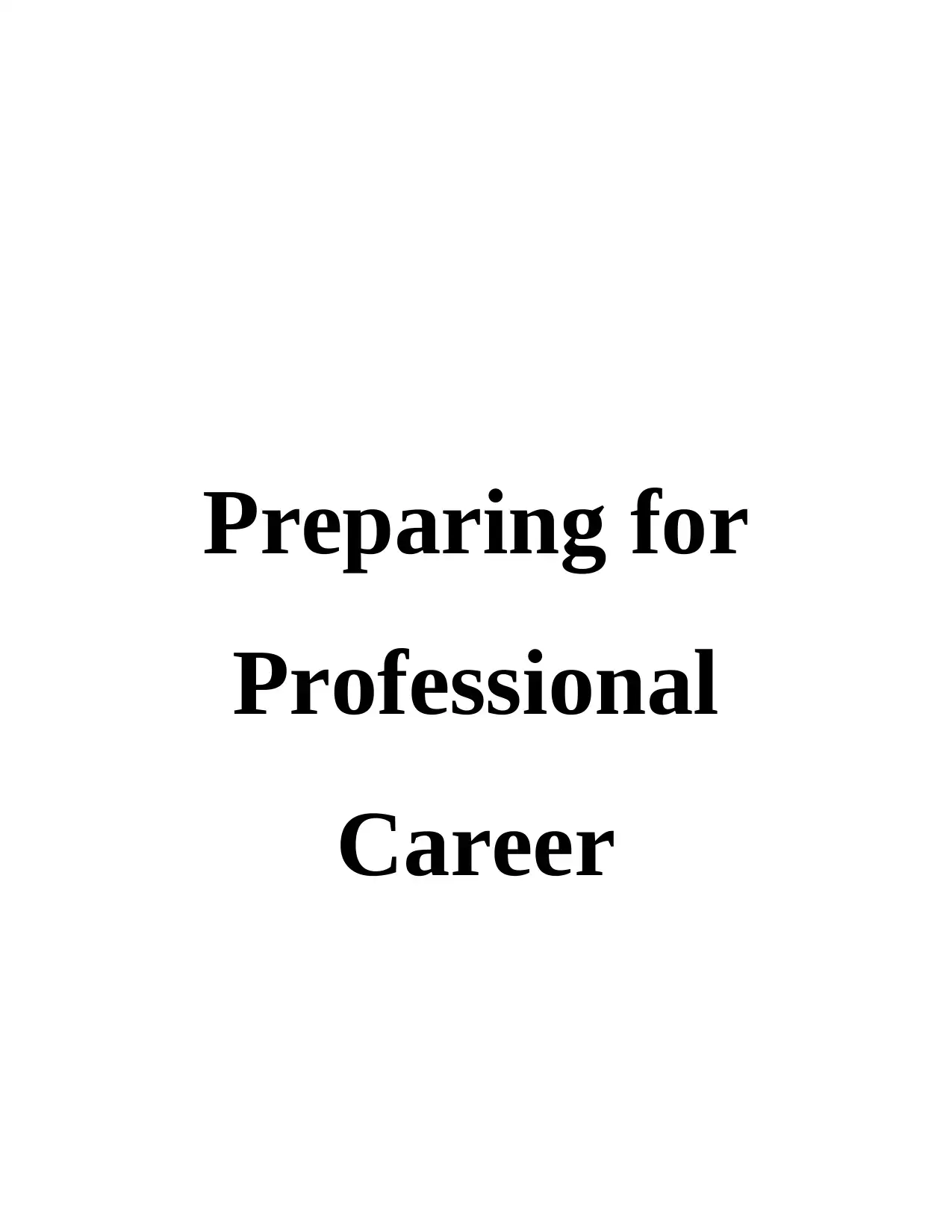
Preparing for
Professional
Career
Professional
Career
Paraphrase This Document
Need a fresh take? Get an instant paraphrase of this document with our AI Paraphraser
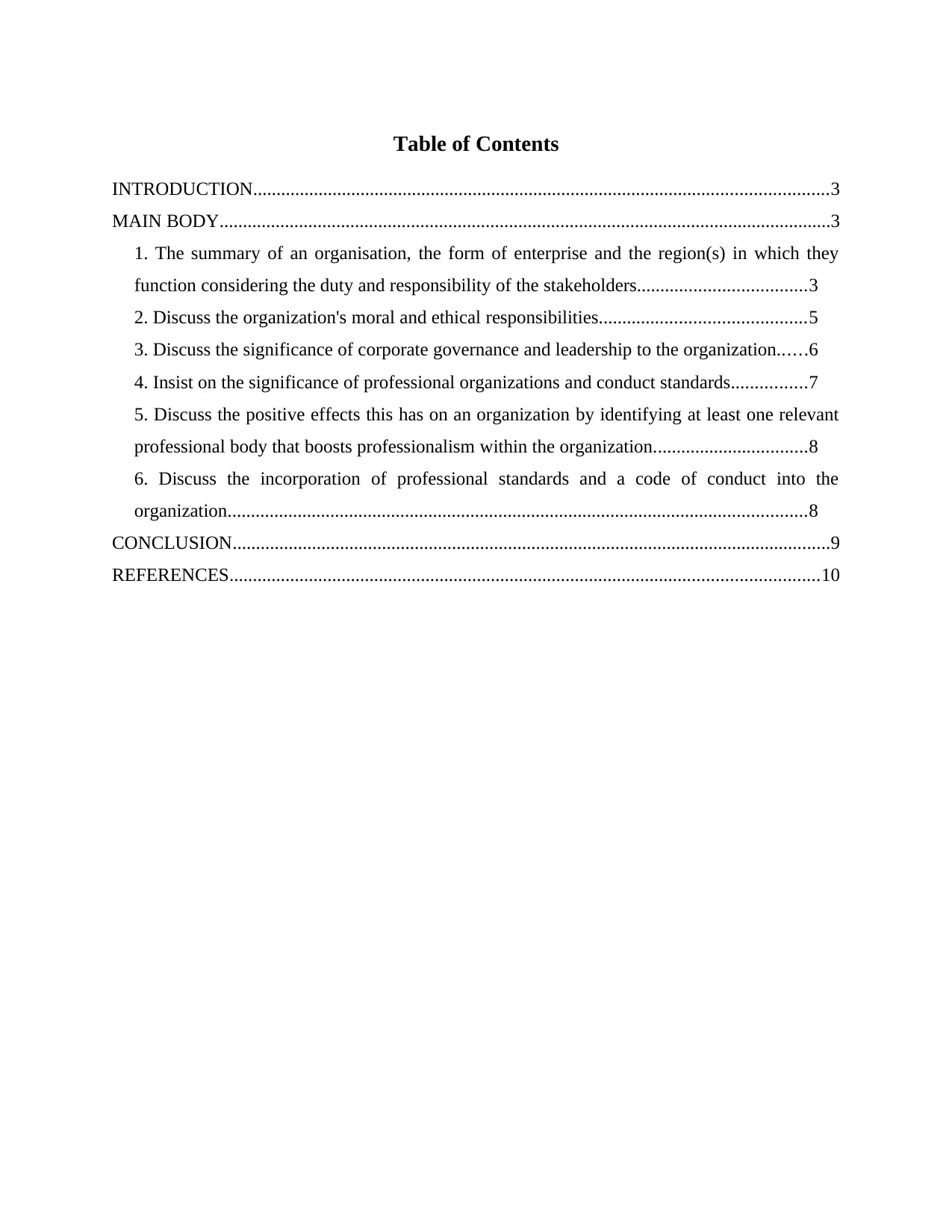
Table of Contents
INTRODUCTION...........................................................................................................................3
MAIN BODY...................................................................................................................................3
1. The summary of an organisation, the form of enterprise and the region(s) in which they
function considering the duty and responsibility of the stakeholders....................................3
2. Discuss the organization's moral and ethical responsibilities............................................5
3. Discuss the significance of corporate governance and leadership to the organization......6
4. Insist on the significance of professional organizations and conduct standards................7
5. Discuss the positive effects this has on an organization by identifying at least one relevant
professional body that boosts professionalism within the organization.................................8
6. Discuss the incorporation of professional standards and a code of conduct into the
organization............................................................................................................................8
CONCLUSION................................................................................................................................9
REFERENCES..............................................................................................................................10
INTRODUCTION...........................................................................................................................3
MAIN BODY...................................................................................................................................3
1. The summary of an organisation, the form of enterprise and the region(s) in which they
function considering the duty and responsibility of the stakeholders....................................3
2. Discuss the organization's moral and ethical responsibilities............................................5
3. Discuss the significance of corporate governance and leadership to the organization......6
4. Insist on the significance of professional organizations and conduct standards................7
5. Discuss the positive effects this has on an organization by identifying at least one relevant
professional body that boosts professionalism within the organization.................................8
6. Discuss the incorporation of professional standards and a code of conduct into the
organization............................................................................................................................8
CONCLUSION................................................................................................................................9
REFERENCES..............................................................................................................................10
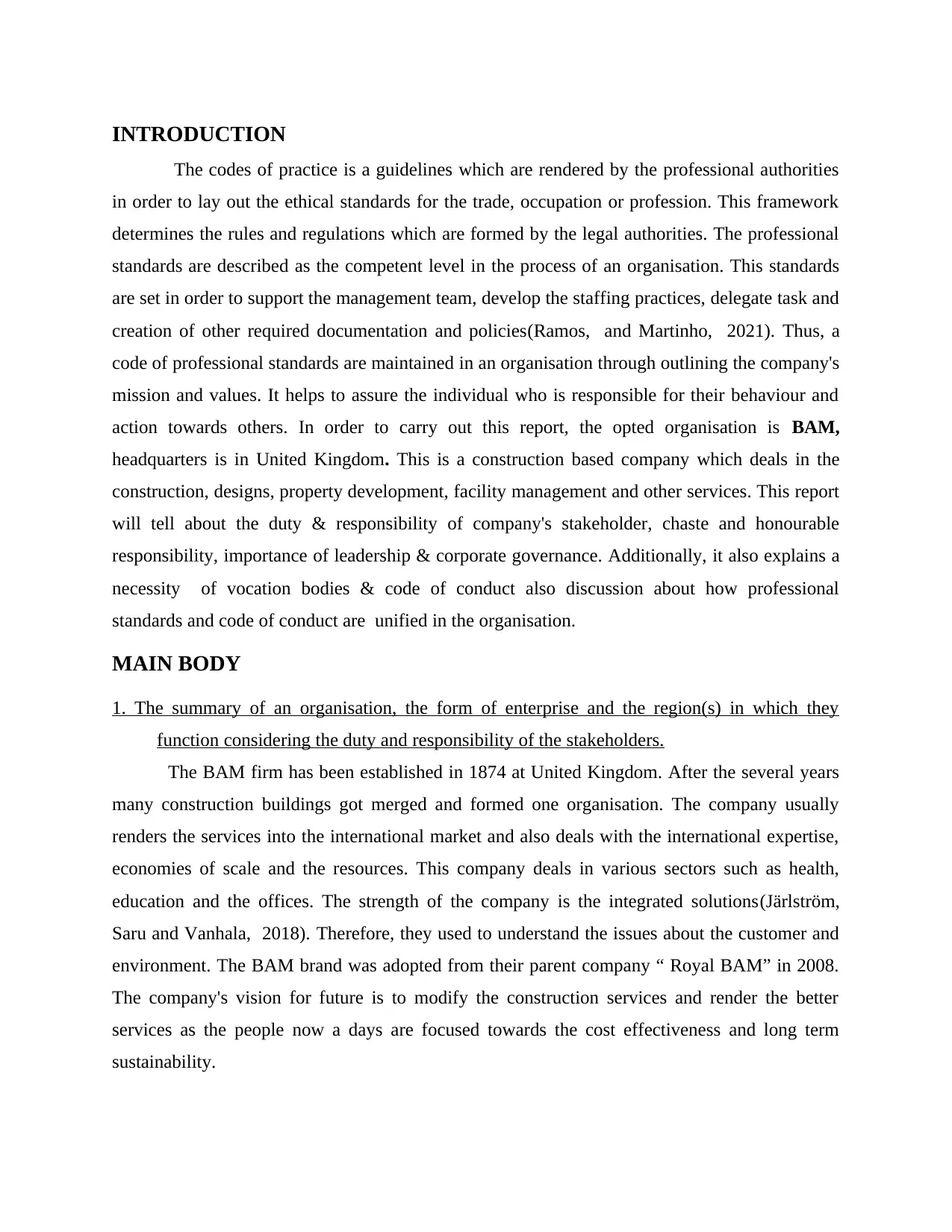
INTRODUCTION
The codes of practice is a guidelines which are rendered by the professional authorities
in order to lay out the ethical standards for the trade, occupation or profession. This framework
determines the rules and regulations which are formed by the legal authorities. The professional
standards are described as the competent level in the process of an organisation. This standards
are set in order to support the management team, develop the staffing practices, delegate task and
creation of other required documentation and policies(Ramos, and Martinho, 2021). Thus, a
code of professional standards are maintained in an organisation through outlining the company's
mission and values. It helps to assure the individual who is responsible for their behaviour and
action towards others. In order to carry out this report, the opted organisation is BAM,
headquarters is in United Kingdom. This is a construction based company which deals in the
construction, designs, property development, facility management and other services. This report
will tell about the duty & responsibility of company's stakeholder, chaste and honourable
responsibility, importance of leadership & corporate governance. Additionally, it also explains a
necessity of vocation bodies & code of conduct also discussion about how professional
standards and code of conduct are unified in the organisation.
MAIN BODY
1. The summary of an organisation, the form of enterprise and the region(s) in which they
function considering the duty and responsibility of the stakeholders.
The BAM firm has been established in 1874 at United Kingdom. After the several years
many construction buildings got merged and formed one organisation. The company usually
renders the services into the international market and also deals with the international expertise,
economies of scale and the resources. This company deals in various sectors such as health,
education and the offices. The strength of the company is the integrated solutions(Järlström,
Saru and Vanhala, 2018). Therefore, they used to understand the issues about the customer and
environment. The BAM brand was adopted from their parent company “ Royal BAM” in 2008.
The company's vision for future is to modify the construction services and render the better
services as the people now a days are focused towards the cost effectiveness and long term
sustainability.
The codes of practice is a guidelines which are rendered by the professional authorities
in order to lay out the ethical standards for the trade, occupation or profession. This framework
determines the rules and regulations which are formed by the legal authorities. The professional
standards are described as the competent level in the process of an organisation. This standards
are set in order to support the management team, develop the staffing practices, delegate task and
creation of other required documentation and policies(Ramos, and Martinho, 2021). Thus, a
code of professional standards are maintained in an organisation through outlining the company's
mission and values. It helps to assure the individual who is responsible for their behaviour and
action towards others. In order to carry out this report, the opted organisation is BAM,
headquarters is in United Kingdom. This is a construction based company which deals in the
construction, designs, property development, facility management and other services. This report
will tell about the duty & responsibility of company's stakeholder, chaste and honourable
responsibility, importance of leadership & corporate governance. Additionally, it also explains a
necessity of vocation bodies & code of conduct also discussion about how professional
standards and code of conduct are unified in the organisation.
MAIN BODY
1. The summary of an organisation, the form of enterprise and the region(s) in which they
function considering the duty and responsibility of the stakeholders.
The BAM firm has been established in 1874 at United Kingdom. After the several years
many construction buildings got merged and formed one organisation. The company usually
renders the services into the international market and also deals with the international expertise,
economies of scale and the resources. This company deals in various sectors such as health,
education and the offices. The strength of the company is the integrated solutions(Järlström,
Saru and Vanhala, 2018). Therefore, they used to understand the issues about the customer and
environment. The BAM brand was adopted from their parent company “ Royal BAM” in 2008.
The company's vision for future is to modify the construction services and render the better
services as the people now a days are focused towards the cost effectiveness and long term
sustainability.
⊘ This is a preview!⊘
Do you want full access?
Subscribe today to unlock all pages.

Trusted by 1+ million students worldwide
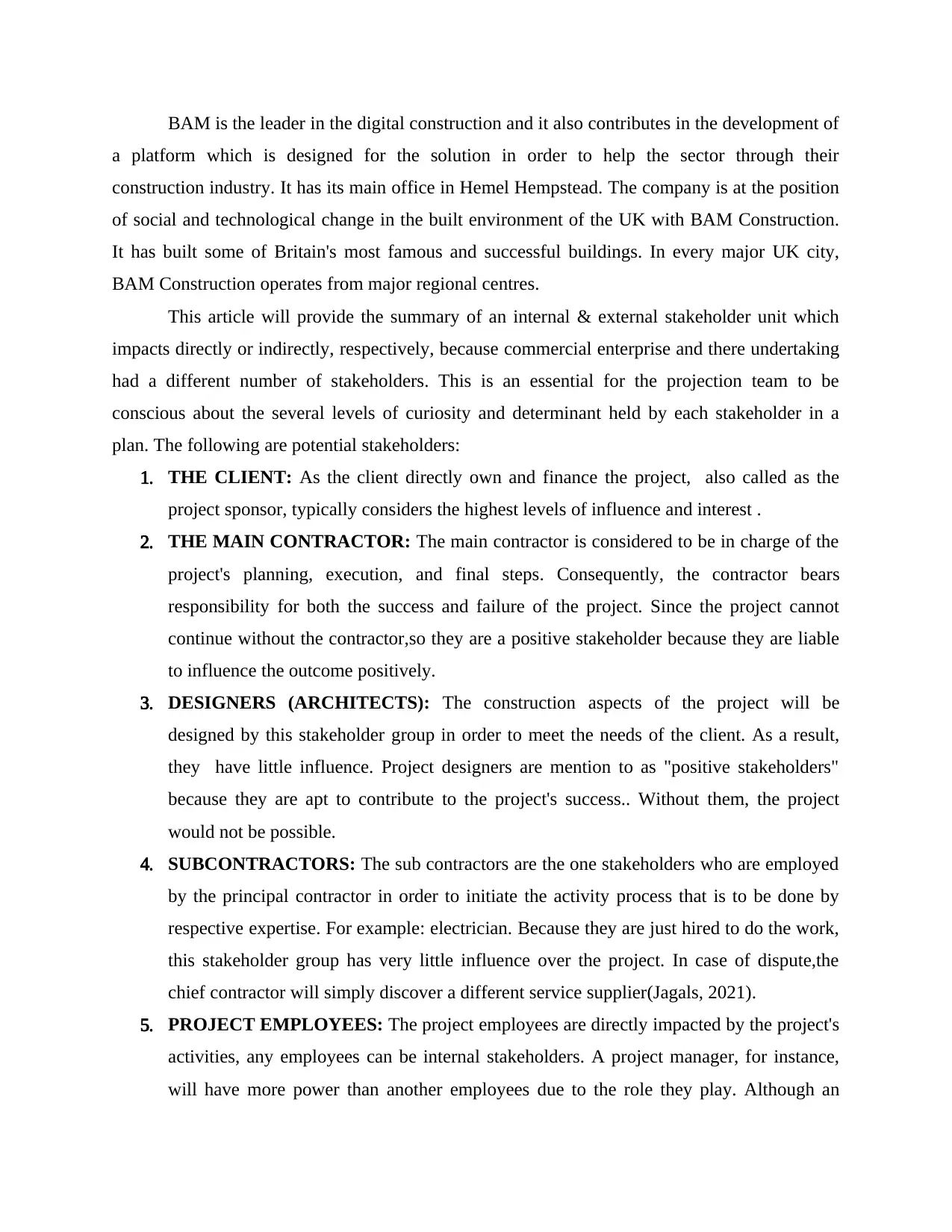
BAM is the leader in the digital construction and it also contributes in the development of
a platform which is designed for the solution in order to help the sector through their
construction industry. It has its main office in Hemel Hempstead. The company is at the position
of social and technological change in the built environment of the UK with BAM Construction.
It has built some of Britain's most famous and successful buildings. In every major UK city,
BAM Construction operates from major regional centres.
This article will provide the summary of an internal & external stakeholder unit which
impacts directly or indirectly, respectively, because commercial enterprise and there undertaking
had a different number of stakeholders. This is an essential for the projection team to be
conscious about the several levels of curiosity and determinant held by each stakeholder in a
plan. The following are potential stakeholders:
1. THE CLIENT: As the client directly own and finance the project, also called as the
project sponsor, typically considers the highest levels of influence and interest .
2. THE MAIN CONTRACTOR: The main contractor is considered to be in charge of the
project's planning, execution, and final steps. Consequently, the contractor bears
responsibility for both the success and failure of the project. Since the project cannot
continue without the contractor,so they are a positive stakeholder because they are liable
to influence the outcome positively.
3. DESIGNERS (ARCHITECTS): The construction aspects of the project will be
designed by this stakeholder group in order to meet the needs of the client. As a result,
they have little influence. Project designers are mention to as "positive stakeholders"
because they are apt to contribute to the project's success.. Without them, the project
would not be possible.
4. SUBCONTRACTORS: The sub contractors are the one stakeholders who are employed
by the principal contractor in order to initiate the activity process that is to be done by
respective expertise. For example: electrician. Because they are just hired to do the work,
this stakeholder group has very little influence over the project. In case of dispute,the
chief contractor will simply discover a different service supplier(Jagals, 2021).
5. PROJECT EMPLOYEES: The project employees are directly impacted by the project's
activities, any employees can be internal stakeholders. A project manager, for instance,
will have more power than another employees due to the role they play. Although an
a platform which is designed for the solution in order to help the sector through their
construction industry. It has its main office in Hemel Hempstead. The company is at the position
of social and technological change in the built environment of the UK with BAM Construction.
It has built some of Britain's most famous and successful buildings. In every major UK city,
BAM Construction operates from major regional centres.
This article will provide the summary of an internal & external stakeholder unit which
impacts directly or indirectly, respectively, because commercial enterprise and there undertaking
had a different number of stakeholders. This is an essential for the projection team to be
conscious about the several levels of curiosity and determinant held by each stakeholder in a
plan. The following are potential stakeholders:
1. THE CLIENT: As the client directly own and finance the project, also called as the
project sponsor, typically considers the highest levels of influence and interest .
2. THE MAIN CONTRACTOR: The main contractor is considered to be in charge of the
project's planning, execution, and final steps. Consequently, the contractor bears
responsibility for both the success and failure of the project. Since the project cannot
continue without the contractor,so they are a positive stakeholder because they are liable
to influence the outcome positively.
3. DESIGNERS (ARCHITECTS): The construction aspects of the project will be
designed by this stakeholder group in order to meet the needs of the client. As a result,
they have little influence. Project designers are mention to as "positive stakeholders"
because they are apt to contribute to the project's success.. Without them, the project
would not be possible.
4. SUBCONTRACTORS: The sub contractors are the one stakeholders who are employed
by the principal contractor in order to initiate the activity process that is to be done by
respective expertise. For example: electrician. Because they are just hired to do the work,
this stakeholder group has very little influence over the project. In case of dispute,the
chief contractor will simply discover a different service supplier(Jagals, 2021).
5. PROJECT EMPLOYEES: The project employees are directly impacted by the project's
activities, any employees can be internal stakeholders. A project manager, for instance,
will have more power than another employees due to the role they play. Although an
Paraphrase This Document
Need a fresh take? Get an instant paraphrase of this document with our AI Paraphraser
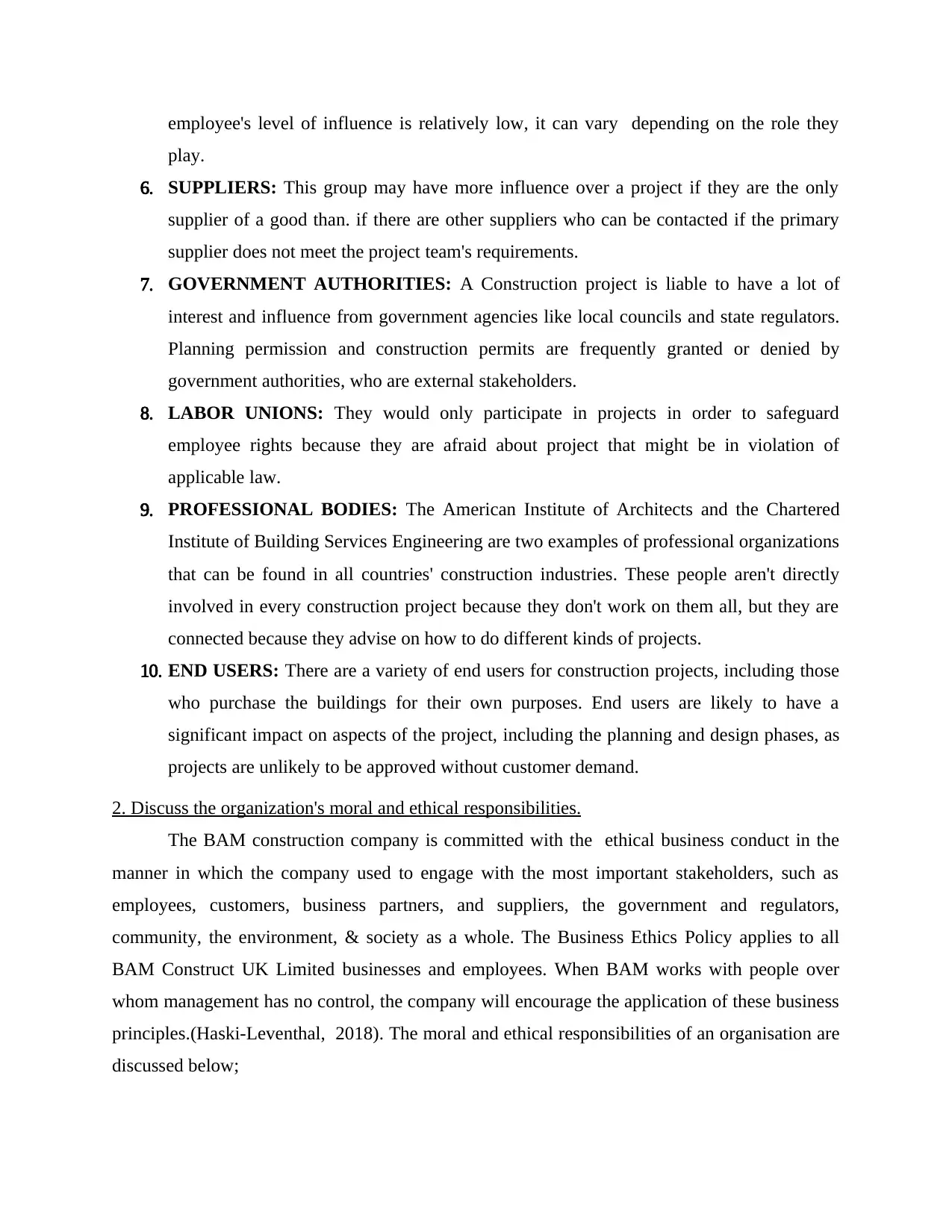
employee's level of influence is relatively low, it can vary depending on the role they
play.
6. SUPPLIERS: This group may have more influence over a project if they are the only
supplier of a good than. if there are other suppliers who can be contacted if the primary
supplier does not meet the project team's requirements.
7. GOVERNMENT AUTHORITIES: A Construction project is liable to have a lot of
interest and influence from government agencies like local councils and state regulators.
Planning permission and construction permits are frequently granted or denied by
government authorities, who are external stakeholders.
8. LABOR UNIONS: They would only participate in projects in order to safeguard
employee rights because they are afraid about project that might be in violation of
applicable law.
9. PROFESSIONAL BODIES: The American Institute of Architects and the Chartered
Institute of Building Services Engineering are two examples of professional organizations
that can be found in all countries' construction industries. These people aren't directly
involved in every construction project because they don't work on them all, but they are
connected because they advise on how to do different kinds of projects.
10. END USERS: There are a variety of end users for construction projects, including those
who purchase the buildings for their own purposes. End users are likely to have a
significant impact on aspects of the project, including the planning and design phases, as
projects are unlikely to be approved without customer demand.
2. Discuss the organization's moral and ethical responsibilities.
The BAM construction company is committed with the ethical business conduct in the
manner in which the company used to engage with the most important stakeholders, such as
employees, customers, business partners, and suppliers, the government and regulators,
community, the environment, & society as a whole. The Business Ethics Policy applies to all
BAM Construct UK Limited businesses and employees. When BAM works with people over
whom management has no control, the company will encourage the application of these business
principles.(Haski-Leventhal, 2018). The moral and ethical responsibilities of an organisation are
discussed below;
play.
6. SUPPLIERS: This group may have more influence over a project if they are the only
supplier of a good than. if there are other suppliers who can be contacted if the primary
supplier does not meet the project team's requirements.
7. GOVERNMENT AUTHORITIES: A Construction project is liable to have a lot of
interest and influence from government agencies like local councils and state regulators.
Planning permission and construction permits are frequently granted or denied by
government authorities, who are external stakeholders.
8. LABOR UNIONS: They would only participate in projects in order to safeguard
employee rights because they are afraid about project that might be in violation of
applicable law.
9. PROFESSIONAL BODIES: The American Institute of Architects and the Chartered
Institute of Building Services Engineering are two examples of professional organizations
that can be found in all countries' construction industries. These people aren't directly
involved in every construction project because they don't work on them all, but they are
connected because they advise on how to do different kinds of projects.
10. END USERS: There are a variety of end users for construction projects, including those
who purchase the buildings for their own purposes. End users are likely to have a
significant impact on aspects of the project, including the planning and design phases, as
projects are unlikely to be approved without customer demand.
2. Discuss the organization's moral and ethical responsibilities.
The BAM construction company is committed with the ethical business conduct in the
manner in which the company used to engage with the most important stakeholders, such as
employees, customers, business partners, and suppliers, the government and regulators,
community, the environment, & society as a whole. The Business Ethics Policy applies to all
BAM Construct UK Limited businesses and employees. When BAM works with people over
whom management has no control, the company will encourage the application of these business
principles.(Haski-Leventhal, 2018). The moral and ethical responsibilities of an organisation are
discussed below;
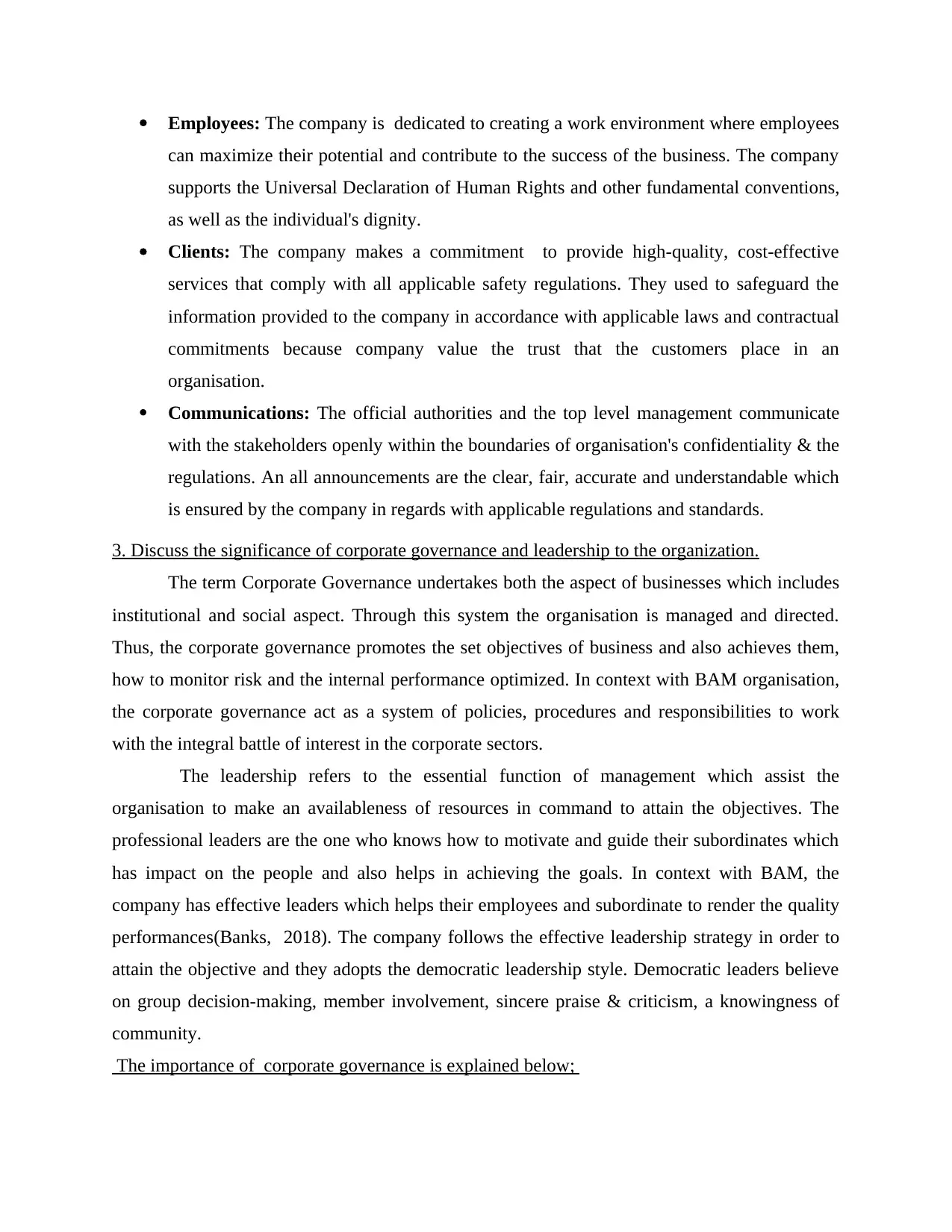
Employees: The company is dedicated to creating a work environment where employees
can maximize their potential and contribute to the success of the business. The company
supports the Universal Declaration of Human Rights and other fundamental conventions,
as well as the individual's dignity.
Clients: The company makes a commitment to provide high-quality, cost-effective
services that comply with all applicable safety regulations. They used to safeguard the
information provided to the company in accordance with applicable laws and contractual
commitments because company value the trust that the customers place in an
organisation.
Communications: The official authorities and the top level management communicate
with the stakeholders openly within the boundaries of organisation's confidentiality & the
regulations. An all announcements are the clear, fair, accurate and understandable which
is ensured by the company in regards with applicable regulations and standards.
3. Discuss the significance of corporate governance and leadership to the organization.
The term Corporate Governance undertakes both the aspect of businesses which includes
institutional and social aspect. Through this system the organisation is managed and directed.
Thus, the corporate governance promotes the set objectives of business and also achieves them,
how to monitor risk and the internal performance optimized. In context with BAM organisation,
the corporate governance act as a system of policies, procedures and responsibilities to work
with the integral battle of interest in the corporate sectors.
The leadership refers to the essential function of management which assist the
organisation to make an availableness of resources in command to attain the objectives. The
professional leaders are the one who knows how to motivate and guide their subordinates which
has impact on the people and also helps in achieving the goals. In context with BAM, the
company has effective leaders which helps their employees and subordinate to render the quality
performances(Banks, 2018). The company follows the effective leadership strategy in order to
attain the objective and they adopts the democratic leadership style. Democratic leaders believe
on group decision-making, member involvement, sincere praise & criticism, a knowingness of
community.
The importance of corporate governance is explained below;
can maximize their potential and contribute to the success of the business. The company
supports the Universal Declaration of Human Rights and other fundamental conventions,
as well as the individual's dignity.
Clients: The company makes a commitment to provide high-quality, cost-effective
services that comply with all applicable safety regulations. They used to safeguard the
information provided to the company in accordance with applicable laws and contractual
commitments because company value the trust that the customers place in an
organisation.
Communications: The official authorities and the top level management communicate
with the stakeholders openly within the boundaries of organisation's confidentiality & the
regulations. An all announcements are the clear, fair, accurate and understandable which
is ensured by the company in regards with applicable regulations and standards.
3. Discuss the significance of corporate governance and leadership to the organization.
The term Corporate Governance undertakes both the aspect of businesses which includes
institutional and social aspect. Through this system the organisation is managed and directed.
Thus, the corporate governance promotes the set objectives of business and also achieves them,
how to monitor risk and the internal performance optimized. In context with BAM organisation,
the corporate governance act as a system of policies, procedures and responsibilities to work
with the integral battle of interest in the corporate sectors.
The leadership refers to the essential function of management which assist the
organisation to make an availableness of resources in command to attain the objectives. The
professional leaders are the one who knows how to motivate and guide their subordinates which
has impact on the people and also helps in achieving the goals. In context with BAM, the
company has effective leaders which helps their employees and subordinate to render the quality
performances(Banks, 2018). The company follows the effective leadership strategy in order to
attain the objective and they adopts the democratic leadership style. Democratic leaders believe
on group decision-making, member involvement, sincere praise & criticism, a knowingness of
community.
The importance of corporate governance is explained below;
⊘ This is a preview!⊘
Do you want full access?
Subscribe today to unlock all pages.

Trusted by 1+ million students worldwide
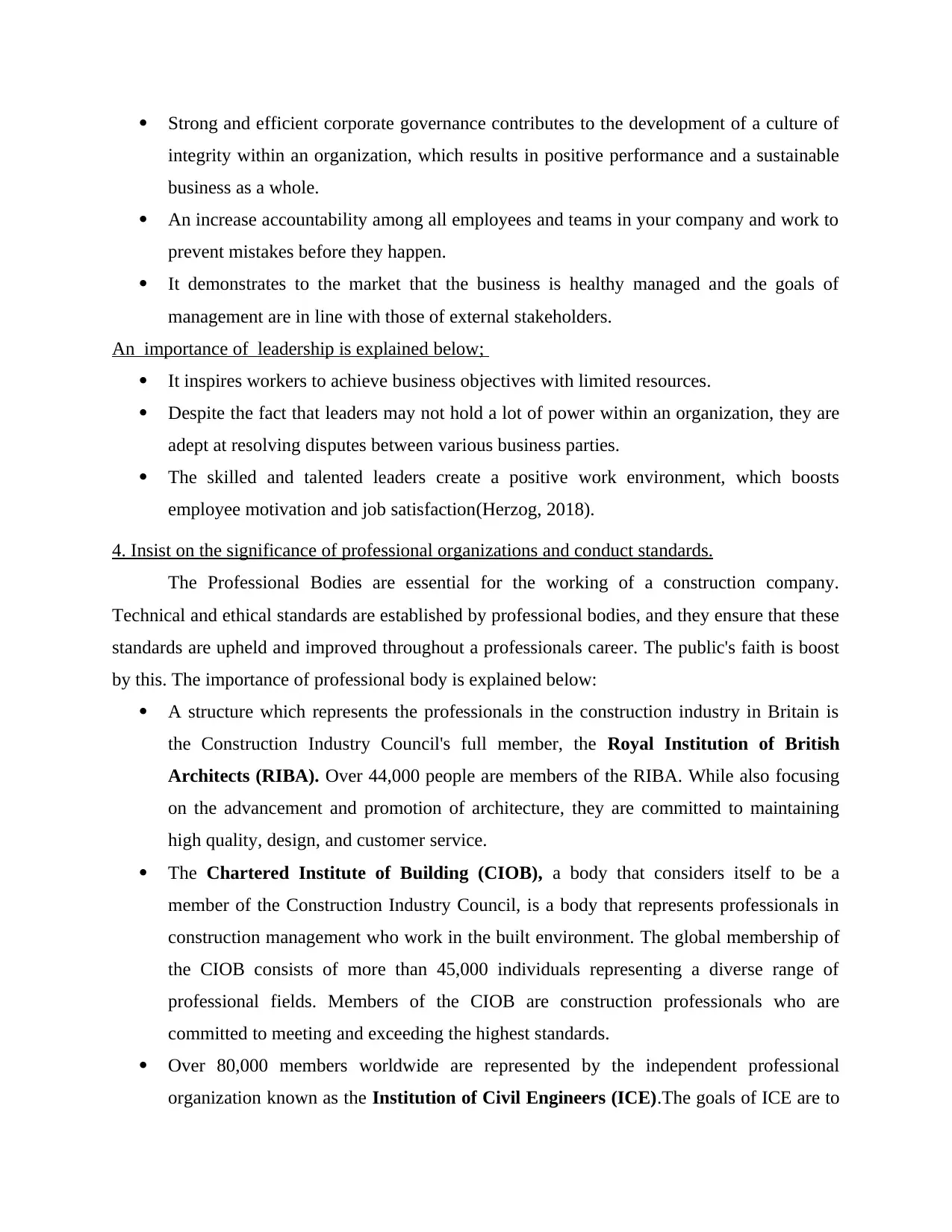
Strong and efficient corporate governance contributes to the development of a culture of
integrity within an organization, which results in positive performance and a sustainable
business as a whole.
An increase accountability among all employees and teams in your company and work to
prevent mistakes before they happen.
It demonstrates to the market that the business is healthy managed and the goals of
management are in line with those of external stakeholders.
An importance of leadership is explained below;
It inspires workers to achieve business objectives with limited resources.
Despite the fact that leaders may not hold a lot of power within an organization, they are
adept at resolving disputes between various business parties.
The skilled and talented leaders create a positive work environment, which boosts
employee motivation and job satisfaction(Herzog, 2018).
4. Insist on the significance of professional organizations and conduct standards.
The Professional Bodies are essential for the working of a construction company.
Technical and ethical standards are established by professional bodies, and they ensure that these
standards are upheld and improved throughout a professionals career. The public's faith is boost
by this. The importance of professional body is explained below:
A structure which represents the professionals in the construction industry in Britain is
the Construction Industry Council's full member, the Royal Institution of British
Architects (RIBA). Over 44,000 people are members of the RIBA. While also focusing
on the advancement and promotion of architecture, they are committed to maintaining
high quality, design, and customer service.
The Chartered Institute of Building (CIOB), a body that considers itself to be a
member of the Construction Industry Council, is a body that represents professionals in
construction management who work in the built environment. The global membership of
the CIOB consists of more than 45,000 individuals representing a diverse range of
professional fields. Members of the CIOB are construction professionals who are
committed to meeting and exceeding the highest standards.
Over 80,000 members worldwide are represented by the independent professional
organization known as the Institution of Civil Engineers (ICE).The goals of ICE are to
integrity within an organization, which results in positive performance and a sustainable
business as a whole.
An increase accountability among all employees and teams in your company and work to
prevent mistakes before they happen.
It demonstrates to the market that the business is healthy managed and the goals of
management are in line with those of external stakeholders.
An importance of leadership is explained below;
It inspires workers to achieve business objectives with limited resources.
Despite the fact that leaders may not hold a lot of power within an organization, they are
adept at resolving disputes between various business parties.
The skilled and talented leaders create a positive work environment, which boosts
employee motivation and job satisfaction(Herzog, 2018).
4. Insist on the significance of professional organizations and conduct standards.
The Professional Bodies are essential for the working of a construction company.
Technical and ethical standards are established by professional bodies, and they ensure that these
standards are upheld and improved throughout a professionals career. The public's faith is boost
by this. The importance of professional body is explained below:
A structure which represents the professionals in the construction industry in Britain is
the Construction Industry Council's full member, the Royal Institution of British
Architects (RIBA). Over 44,000 people are members of the RIBA. While also focusing
on the advancement and promotion of architecture, they are committed to maintaining
high quality, design, and customer service.
The Chartered Institute of Building (CIOB), a body that considers itself to be a
member of the Construction Industry Council, is a body that represents professionals in
construction management who work in the built environment. The global membership of
the CIOB consists of more than 45,000 individuals representing a diverse range of
professional fields. Members of the CIOB are construction professionals who are
committed to meeting and exceeding the highest standards.
Over 80,000 members worldwide are represented by the independent professional
organization known as the Institution of Civil Engineers (ICE).The goals of ICE are to
Paraphrase This Document
Need a fresh take? Get an instant paraphrase of this document with our AI Paraphraser
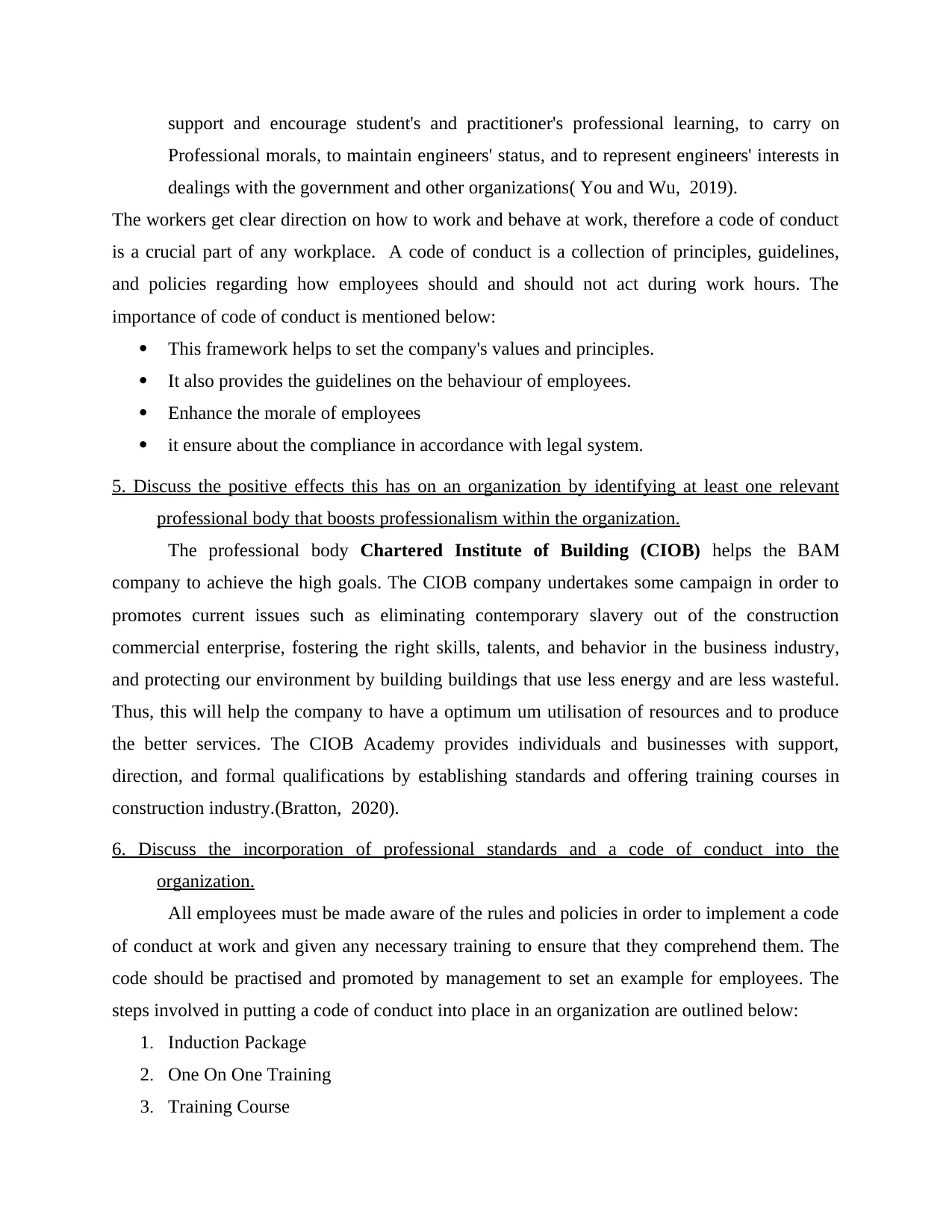
support and encourage student's and practitioner's professional learning, to carry on
Professional morals, to maintain engineers' status, and to represent engineers' interests in
dealings with the government and other organizations( You and Wu, 2019).
The workers get clear direction on how to work and behave at work, therefore a code of conduct
is a crucial part of any workplace. A code of conduct is a collection of principles, guidelines,
and policies regarding how employees should and should not act during work hours. The
importance of code of conduct is mentioned below:
This framework helps to set the company's values and principles.
It also provides the guidelines on the behaviour of employees.
Enhance the morale of employees
it ensure about the compliance in accordance with legal system.
5. Discuss the positive effects this has on an organization by identifying at least one relevant
professional body that boosts professionalism within the organization.
The professional body Chartered Institute of Building (CIOB) helps the BAM
company to achieve the high goals. The CIOB company undertakes some campaign in order to
promotes current issues such as eliminating contemporary slavery out of the construction
commercial enterprise, fostering the right skills, talents, and behavior in the business industry,
and protecting our environment by building buildings that use less energy and are less wasteful.
Thus, this will help the company to have a optimum um utilisation of resources and to produce
the better services. The CIOB Academy provides individuals and businesses with support,
direction, and formal qualifications by establishing standards and offering training courses in
construction industry.(Bratton, 2020).
6. Discuss the incorporation of professional standards and a code of conduct into the
organization.
All employees must be made aware of the rules and policies in order to implement a code
of conduct at work and given any necessary training to ensure that they comprehend them. The
code should be practised and promoted by management to set an example for employees. The
steps involved in putting a code of conduct into place in an organization are outlined below:
1. Induction Package
2. One On One Training
3. Training Course
Professional morals, to maintain engineers' status, and to represent engineers' interests in
dealings with the government and other organizations( You and Wu, 2019).
The workers get clear direction on how to work and behave at work, therefore a code of conduct
is a crucial part of any workplace. A code of conduct is a collection of principles, guidelines,
and policies regarding how employees should and should not act during work hours. The
importance of code of conduct is mentioned below:
This framework helps to set the company's values and principles.
It also provides the guidelines on the behaviour of employees.
Enhance the morale of employees
it ensure about the compliance in accordance with legal system.
5. Discuss the positive effects this has on an organization by identifying at least one relevant
professional body that boosts professionalism within the organization.
The professional body Chartered Institute of Building (CIOB) helps the BAM
company to achieve the high goals. The CIOB company undertakes some campaign in order to
promotes current issues such as eliminating contemporary slavery out of the construction
commercial enterprise, fostering the right skills, talents, and behavior in the business industry,
and protecting our environment by building buildings that use less energy and are less wasteful.
Thus, this will help the company to have a optimum um utilisation of resources and to produce
the better services. The CIOB Academy provides individuals and businesses with support,
direction, and formal qualifications by establishing standards and offering training courses in
construction industry.(Bratton, 2020).
6. Discuss the incorporation of professional standards and a code of conduct into the
organization.
All employees must be made aware of the rules and policies in order to implement a code
of conduct at work and given any necessary training to ensure that they comprehend them. The
code should be practised and promoted by management to set an example for employees. The
steps involved in putting a code of conduct into place in an organization are outlined below:
1. Induction Package
2. One On One Training
3. Training Course
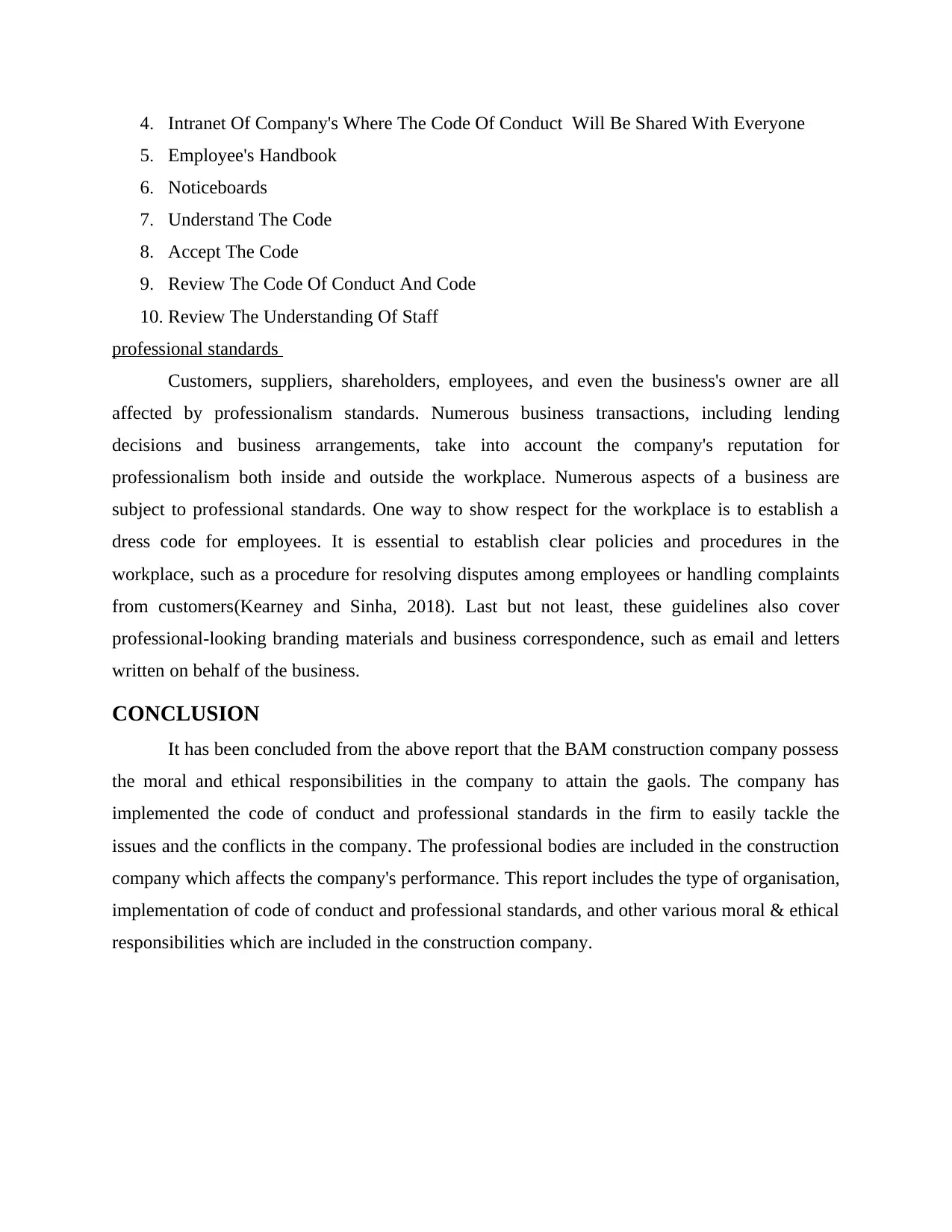
4. Intranet Of Company's Where The Code Of Conduct Will Be Shared With Everyone
5. Employee's Handbook
6. Noticeboards
7. Understand The Code
8. Accept The Code
9. Review The Code Of Conduct And Code
10. Review The Understanding Of Staff
professional standards
Customers, suppliers, shareholders, employees, and even the business's owner are all
affected by professionalism standards. Numerous business transactions, including lending
decisions and business arrangements, take into account the company's reputation for
professionalism both inside and outside the workplace. Numerous aspects of a business are
subject to professional standards. One way to show respect for the workplace is to establish a
dress code for employees. It is essential to establish clear policies and procedures in the
workplace, such as a procedure for resolving disputes among employees or handling complaints
from customers(Kearney and Sinha, 2018). Last but not least, these guidelines also cover
professional-looking branding materials and business correspondence, such as email and letters
written on behalf of the business.
CONCLUSION
It has been concluded from the above report that the BAM construction company possess
the moral and ethical responsibilities in the company to attain the gaols. The company has
implemented the code of conduct and professional standards in the firm to easily tackle the
issues and the conflicts in the company. The professional bodies are included in the construction
company which affects the company's performance. This report includes the type of organisation,
implementation of code of conduct and professional standards, and other various moral & ethical
responsibilities which are included in the construction company.
5. Employee's Handbook
6. Noticeboards
7. Understand The Code
8. Accept The Code
9. Review The Code Of Conduct And Code
10. Review The Understanding Of Staff
professional standards
Customers, suppliers, shareholders, employees, and even the business's owner are all
affected by professionalism standards. Numerous business transactions, including lending
decisions and business arrangements, take into account the company's reputation for
professionalism both inside and outside the workplace. Numerous aspects of a business are
subject to professional standards. One way to show respect for the workplace is to establish a
dress code for employees. It is essential to establish clear policies and procedures in the
workplace, such as a procedure for resolving disputes among employees or handling complaints
from customers(Kearney and Sinha, 2018). Last but not least, these guidelines also cover
professional-looking branding materials and business correspondence, such as email and letters
written on behalf of the business.
CONCLUSION
It has been concluded from the above report that the BAM construction company possess
the moral and ethical responsibilities in the company to attain the gaols. The company has
implemented the code of conduct and professional standards in the firm to easily tackle the
issues and the conflicts in the company. The professional bodies are included in the construction
company which affects the company's performance. This report includes the type of organisation,
implementation of code of conduct and professional standards, and other various moral & ethical
responsibilities which are included in the construction company.
⊘ This is a preview!⊘
Do you want full access?
Subscribe today to unlock all pages.

Trusted by 1+ million students worldwide
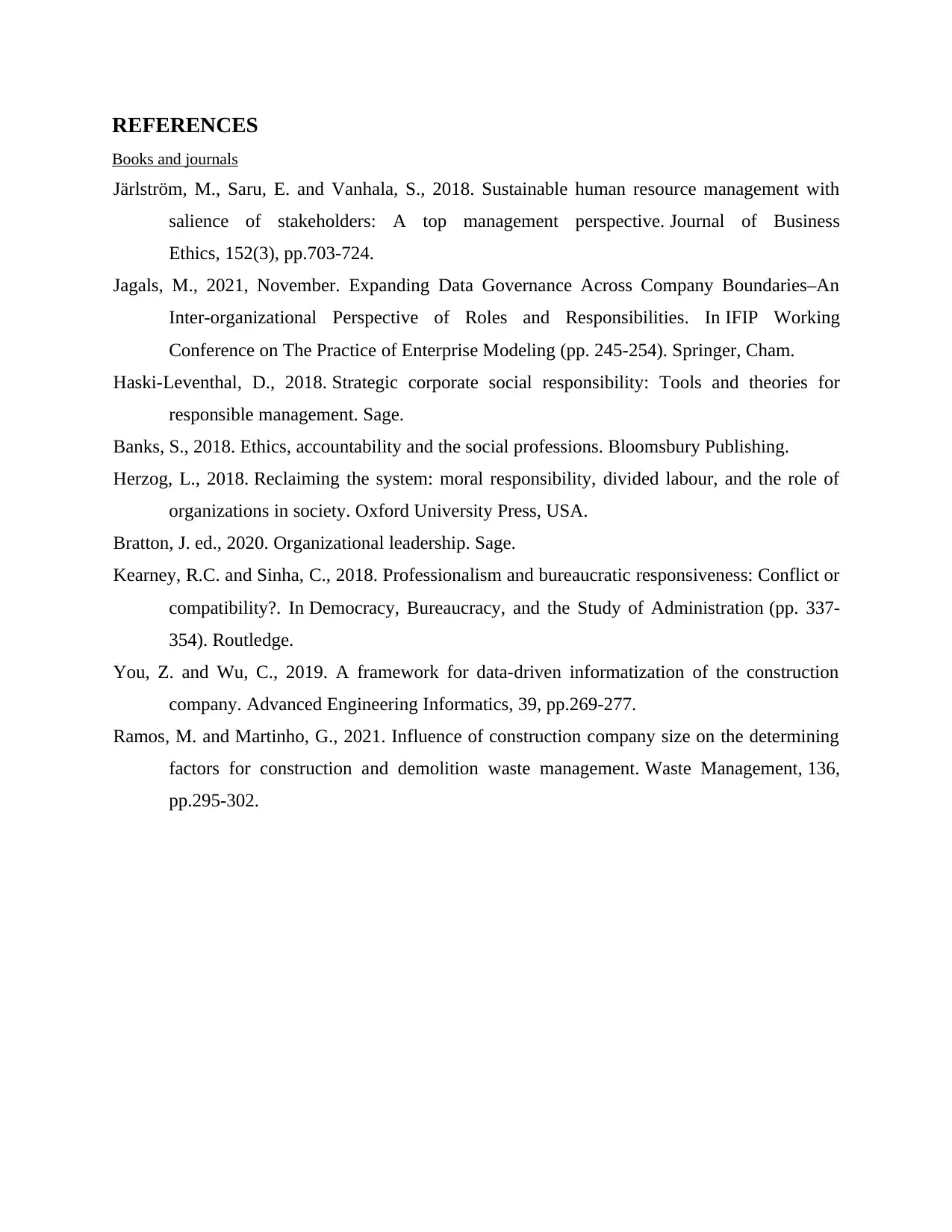
REFERENCES
Books and journals
Järlström, M., Saru, E. and Vanhala, S., 2018. Sustainable human resource management with
salience of stakeholders: A top management perspective. Journal of Business
Ethics, 152(3), pp.703-724.
Jagals, M., 2021, November. Expanding Data Governance Across Company Boundaries–An
Inter-organizational Perspective of Roles and Responsibilities. In IFIP Working
Conference on The Practice of Enterprise Modeling (pp. 245-254). Springer, Cham.
Haski-Leventhal, D., 2018. Strategic corporate social responsibility: Tools and theories for
responsible management. Sage.
Banks, S., 2018. Ethics, accountability and the social professions. Bloomsbury Publishing.
Herzog, L., 2018. Reclaiming the system: moral responsibility, divided labour, and the role of
organizations in society. Oxford University Press, USA.
Bratton, J. ed., 2020. Organizational leadership. Sage.
Kearney, R.C. and Sinha, C., 2018. Professionalism and bureaucratic responsiveness: Conflict or
compatibility?. In Democracy, Bureaucracy, and the Study of Administration (pp. 337-
354). Routledge.
You, Z. and Wu, C., 2019. A framework for data-driven informatization of the construction
company. Advanced Engineering Informatics, 39, pp.269-277.
Ramos, M. and Martinho, G., 2021. Influence of construction company size on the determining
factors for construction and demolition waste management. Waste Management, 136,
pp.295-302.
Books and journals
Järlström, M., Saru, E. and Vanhala, S., 2018. Sustainable human resource management with
salience of stakeholders: A top management perspective. Journal of Business
Ethics, 152(3), pp.703-724.
Jagals, M., 2021, November. Expanding Data Governance Across Company Boundaries–An
Inter-organizational Perspective of Roles and Responsibilities. In IFIP Working
Conference on The Practice of Enterprise Modeling (pp. 245-254). Springer, Cham.
Haski-Leventhal, D., 2018. Strategic corporate social responsibility: Tools and theories for
responsible management. Sage.
Banks, S., 2018. Ethics, accountability and the social professions. Bloomsbury Publishing.
Herzog, L., 2018. Reclaiming the system: moral responsibility, divided labour, and the role of
organizations in society. Oxford University Press, USA.
Bratton, J. ed., 2020. Organizational leadership. Sage.
Kearney, R.C. and Sinha, C., 2018. Professionalism and bureaucratic responsiveness: Conflict or
compatibility?. In Democracy, Bureaucracy, and the Study of Administration (pp. 337-
354). Routledge.
You, Z. and Wu, C., 2019. A framework for data-driven informatization of the construction
company. Advanced Engineering Informatics, 39, pp.269-277.
Ramos, M. and Martinho, G., 2021. Influence of construction company size on the determining
factors for construction and demolition waste management. Waste Management, 136,
pp.295-302.
1 out of 10
Related Documents
Your All-in-One AI-Powered Toolkit for Academic Success.
+13062052269
info@desklib.com
Available 24*7 on WhatsApp / Email
![[object Object]](/_next/static/media/star-bottom.7253800d.svg)
Unlock your academic potential
Copyright © 2020–2025 A2Z Services. All Rights Reserved. Developed and managed by ZUCOL.





